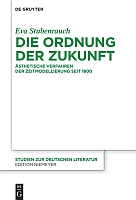Die Ordnung der Zukunft
Ästhetische Verfahren der Zeitmodellierung seit 1800
| dc.contributor.author | Stubenrauch, Eva | |
| dc.date.accessioned | 2023-06-20T06:31:02Z | |
| dc.date.available | 2023-06-20T06:31:02Z | |
| dc.date.issued | 2023 | |
| dc.identifier | ONIX_20230620_9783111015507_24 | |
| dc.identifier.issn | 0081-7236 | |
| dc.identifier.uri | https://library.oapen.org/handle/20.500.12657/63518 | |
| dc.language | German | |
| dc.relation.ispartofseries | Studien zur deutschen Literatur | |
| dc.subject.classification | thema EDItEUR::D Biography, Literature and Literary studies::D Biography, Literature and Literary studies::DS Literature: history and criticism | en_US |
| dc.subject.classification | thema EDItEUR::D Biography, Literature and Literary studies::DS Literature: history and criticism::DSB Literary studies: general::DSBH Literary studies: c 1900 to c 2000 | en_US |
| dc.subject.other | future models | |
| dc.subject.other | future narratives, destiny | |
| dc.title | Die Ordnung der Zukunft | |
| dc.title.alternative | Ästhetische Verfahren der Zeitmodellierung seit 1800 | |
| dc.type | book | |
| oapen.abstract.otherlanguage | The future is open: This is a basic assumption of modernity. It originated in the 18th century and still shapes our self-image today. This study uncovers another tradition: the effort to close the future again, to ‘fill it up’ with orders, models and political expectations. The theoretical and literary procedures of this closure from the period around 1800 recur in later phases of modernity as well. | |
| oapen.identifier.doi | 10.1515/9783111015507 | |
| oapen.relation.isPublishedBy | 2b386f62-fc18-4108-bcf1-ade3ed4cf2f3 | |
| oapen.relation.isFundedBy | 89a0b9f9-a50d-4404-9287-20146c84b852 | |
| oapen.relation.isbn | 9783111015507 | |
| oapen.relation.isbn | 9783111015118 | |
| oapen.relation.isbn | 9783111015767 | |
| oapen.imprint | De Gruyter | |
| oapen.series.number | 230 | |
| oapen.pages | 444 | |
| oapen.place.publication | Berlin/Boston | |
| oapen.grant.number | [...] |

